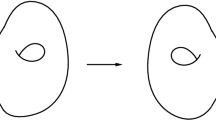Abstract
In this paper, we study the behavior of a sequence of harmonic maps from surfaces with uniformly bounded energy on the generalized neck domain. The generalized neck domain is a union of ghost bubbles and annular neck domains, which connects non-trivial bubbles. An upper bound of the energy density is proved and we use it to study the limit of the nullity and index of the sequence.




Similar content being viewed by others
References
Ai, W., Yin, H.: Neck analysis of extrinsic polyharmonic maps. Ann. Global Anal. Geom. 52(2), 129–156 (2017)
Colding, T.H., Minicozzi, W.P.: A Course in Minimal Surfaces, vol. 121. American Mathematical Soc (2011)
Chen, B., Song, C.: Isolated Singularities of Yang–Mills–Higgs fields on surfaces (2019). arXiv:1907.07092
Ding, W., Tian, G.: Energy identity for a class of approximate harmonic maps from surfaces. Commun. Anal. Geom. 3(4), 543–554 (1995)
Lin, F., Wang, C.: Energy identity of harmonic map flows from surfaces at finite singular time. Calc. Var. Partial Differ. Equ. 6(4), 369–380 (1998)
Liu, L., Yin, H.: Neck analysis for biharmonic maps. Math. Z. 283(3–4), 807–834 (2016)
Parker, T.H.: Bubble tree convergence for harmonic maps. J. Differ. Geom. 44(3), 595–633 (1996)
Qing, J., Tian, G.: Bubbling of the heat flows for harmonic maps from surfaces. Commun. Pure Appl. Math. 50(4), 295–310 (1997)
Rade, J.: Decay estimates for yang-mills fields: two new proofs. In: Global Analysis in Modern Mathematics (Orono, 1991, Waltham, 1992), Publish or Perish, Houston, pp. 91–105 (1993)
Sampson, J.H.: Some properties and applications of harmonic mappings. Ann. Sci. École Norm. Sup. 11(4), 211–228 (1978)
Simon, L.: Asymptotics for a class of nonlinear evolution equations, with applications to geometric problems. Ann. Math. 118(3), 525–571 (1983)
Yin, H.: Higher order neck analysis of harmonic maps and its applications (2019). arXiv:1904.07354
Acknowledgements
The author thanks Professor Yuxiang Li for numerous discussions on conformal immersion and its relation to harmonic maps. This research is supported by NSFC11971451.
Author information
Authors and Affiliations
Corresponding author
Additional information
Communicated by J. Jost.
Publisher's Note
Springer Nature remains neutral with regard to jurisdictional claims in published maps and institutional affiliations.
Appendix A. Some properties of an ODE solution
Appendix A. Some properties of an ODE solution
In this appendix, we show some elementary properties of the solution g(t) to the ordinary differential equation with boundary values
We assume that \(\gamma >1/2\) and \(T>5\). They are not essential and we assume these for simplicity.
Lemma A.1
There is a universal constant \({\tilde{c}}\) such that for any positive constants a and b with \(b\ge a\), we have
and
Remark A.2
In general, since b may be very large, even a lot larger than \(e^{\gamma T}a\), we can not expect an upper bound of \((\log g)'\) over [0, T]. The observation is that such an upper bound holds for [1, T] regardless of the size of a, b and T.
The proof follows from explicit computation, since we have the following formula for the solution
Direct computation shows
and
Taking one more derivative, we get
-
(i)
If a and b are comparable in the sense that \(a\le b\le e^{\gamma T}a\), the lemma holds with \({\tilde{c}}=\gamma \). To see this, we notice that in this case
$$\begin{aligned} {a e^{2\gamma T}- be^{\gamma T}}, {b e^{\gamma T}-a}\ge 0. \end{aligned}$$Hence, by (71), we have \(\left| (\log g)'\right| \le \gamma \) for all \(t\in [0,T]\), from which both (67) and (68) follow.
-
(ii)
If \(b\ge e^{\gamma T}a\), (70) implies that \(g'\ge 0\). Hence, g is increasing and (68) follows.
Moreover, (72) implies that \((\log g)''\le 0\). Together with the observation
it suffices to bound \((\log g)'(1)\), which we compute
Finally, we notice that
which implies that
This concludes the proof of the lemma.
Rights and permissions
About this article
Cite this article
Yin, H. Generalized neck analysis of harmonic maps from surfaces. Calc. Var. 60, 117 (2021). https://doi.org/10.1007/s00526-021-01978-8
Received:
Accepted:
Published:
DOI: https://doi.org/10.1007/s00526-021-01978-8



